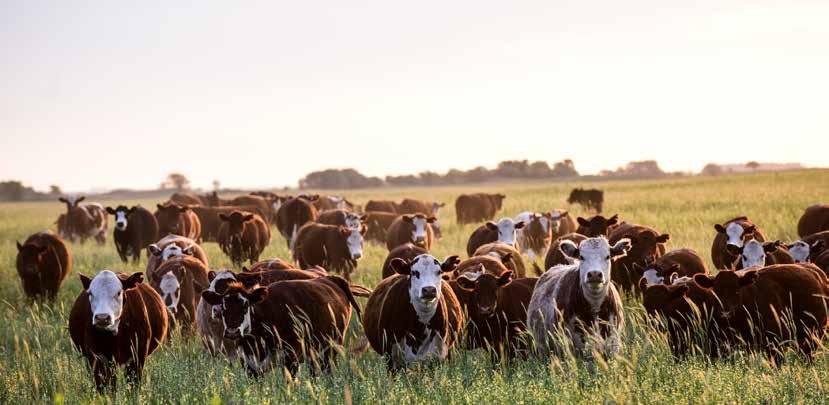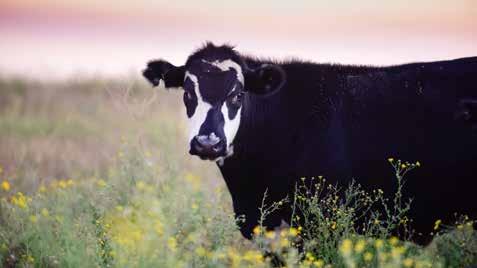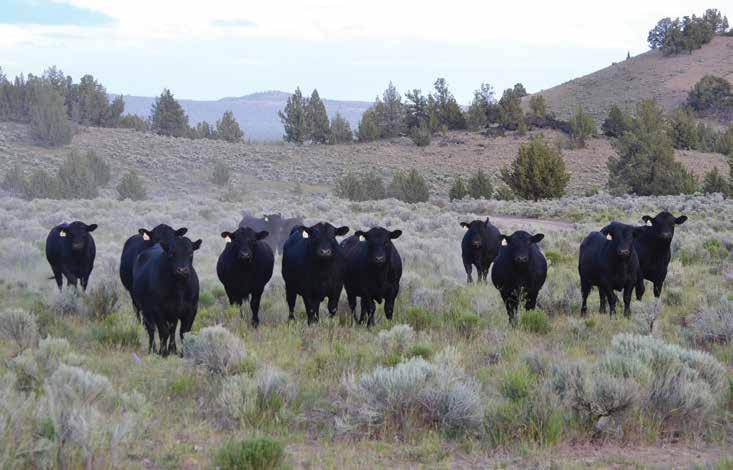
13 minute read
Commerical heifer selection
COMMERCIAL REPLACEMENT HEIFER SELECTION
by Alison Van Eenennaam, Ph.D., University of California, Davis, and Darrh Bullock, Ph.D., University of Kentucky
Advertisement
Traits that are of the most economic value to self-replacing herds are reproductive traits including age at first calving, reproductive success and reproductive longevity or stayability. These maternal traits are sex-limited, lowly heritable, and some are expressed quite late in life. This has precluded direct selection on these traits when selecting commercial replacement heifers, and impeded genetic progress. In fact, the antagonism between carcass traits and some maternal and calving traits may have led to negative progress (e.g. carcass weight is positively correlated with mature weight), as positive selection on the terminal traits can result in negative selection on the maternal traits. Improvements in reproductive performance can be up to four-fold more important in terms of the bottom line than improvements in end-product traits in a conventional cow-calf operation selling market calves at weaning.
Given the economic importance of reproduction, commercial cow-calf producers raising their own replacement heifers should focus some of their selection emphasis on maternal traits. However, most commercial producers have no expected progeny differences (EPDs) information upon which to base their replacement heifer selection decisions.
Selection is frequently driven by size, as an indicator of age; smaller heifers are often the ones that are born late(r) in the calving season and are too immature to be cycling in time for the first potential breeding season. Commercial producers typically select on at least a visual estimate of a heifer’s yearling weight, in addition to a visual evaluation of structural soundness. If increased size is due to age then this will put indirect selection on fertility traits of the dam (e.g. early calving), however if increased size is due to genetics for growth then it can lead to inadvertent selection for increased mature weight. Ideally animals born in the first 21 days of the breeding system would be selected, however commercial producers often do not record birth dates and so have to 68 California Cattleman September2020 estimate the likely birthdate based on the size of the calf.
DNA testing offers an appealing approach to provide previously-absent selection criteria. Theoretically, DNA tests are ideally suited for traits where there is no other tool available for selection. Ironically, research shows that DNA tests for lowly heritable traits will be the most difficult to develop. That is because a very large amount of data (e.g., a large number of performance records) will be required to develop accurate DNA tests for lowly heritable traits. Additionally, such tests will also be the most difficult to evaluate as there is a shortage of cattle populations with sufficient phenotypic data to estimate the accuracy of new genomic tests for those traits.
It was shown early on that 50,000 SNP (50K) DNA tests developed using information from one breed have low predictive ability in other breeds. This is thought to be due to the fact that much of the accuracy of genomic breeding values results from the effect of large chromosome segments that segregate within closely related animals in one breed, but not across breeds.
Practically this means that each breed needs to develop their own database of phenotyped and genotyped animals. There are a number of breeds (Angus, Brangus, Charolais, Gelbvieh, Hereford, Limousin, Red Angus, Simmental and Santa Gertrudis) that have done this by genotyping at least one thousand, and in some cases tens of thousands, of animals with EPDs and phenotypic records to develop DNA tests that are accurate for genomic prediction within those breeds. This genomic information is starting to be incorporated into National Cattle Evaluations and the resulting “genomic-enhanced EPD” have increased accuracies, especially on young animals. For more information see: “How DNA Testing Will Affect the Accuracy of EPD Information” factsheet at eBEEF.org.
Est. 1974

Bull Sale
OCTOBER 17 • 1 P.M. • LAMBERT RANCH, OROVILLE
Horned and Polled Hereford bulls bred, raised in the mountains and developed in the hot valley — ready to perform in any environment! OFFERING SONS OF THESE ALL-AROUND PERFORMANCE HERDSIRES...

NJW 73S 3304 GUNSLINGER 86D ET XAMR RIBSTONE DOMINO 613 SIRE: UPS UNDISPUTED ET • MGS: PW VICTOR BOOMER P606 SIRE: UPS DOMINO 1544 • MGS: UPS RIBSTONE 9713 CED BW WW YW M&G MB RE $CHB CED BW WW YW M&G MB RE $CHB -2.0 3.2 60 102 66 .18 .75 123 +4.6 2.9 51 87 54 .16 .44 101 COME BY THE RANCH TO CHECK OUT MORE OF THIS YEAR’S OFFERING! ALSO VISIT US ONLINE AT LAMBERTRANCHHEREFORDS.COM TO VIEW BULLS!



REG # 44043215 REG # 44043216 REG # 44043219 REG # 44043225
HORNED • LONG-MADE • FREE-MOVING POLLED • PIGMENTED • DARK RED HORNED • SQUARE • EASY-DOING POLLED • DEEP • ATHLETIC
The Lambert Family Steve Lambert (530) 624-5256 slambert@digitalpath.net
ALSO WELCOMING A GREAT SET OF ANGUS BULLS FROM THESE REPUTABLE BREEDERS:
Gary Ford, Sunbright Angus: (530) 526-6128 Joel Popkin, Tara Farms: (530) 865-3600 Dave Holden, West Wind Angus: (530) 553-3090
Sire Selection Drives Genetic Gain
When making selection decisions to improve fertility it is important to remember that genetic gain in herds is predominately driven by sire selection. Although it may seem intuitive to focus on female selection to drive fertility, bulls are where selection focus should lie. That is because sires have a larger number of offspring per year (approximately 25-35) than females who typically have a single calf per year. Figure 1 shows that 87.5 percent of genetic composition of the calf crop is determined by the sires used over the last three generations. There are some EPDs directly related to fertility including heifer pregnancy and stayability.

FIGURE 1.Genetic composition of the herd: 87.5% of genetic composition of calf crop is determined by the sires used over the last three generations.
Use of Genomic Information
The value of using DNA information in making replacement heifer selection decisions will depend upon the information available at the time of selection (e.g. phenotypic measurements, parentage data, EPDs), the accuracy of the test with regard to the selection objective and the replacement rate. Typically only a subset of heifers are replacement candidates due to size, other selection criteria (e.g. feet and legs, disposition) and replacement rate (i.e. what proportion of replacement heifers are selected to return to the herd each year). If EPDs are known on the sires of your replacement females then you have an estimate of half of their genetics. Therefore, parentage testing for sires can be a very useful genomics tool to assist in heifer selection and is much less expensive than genomically testing all of the heifers.
To illustrate the interplay between accuracy, heritability and phenotype, consider a test that explains a quarter of the genetic variation (meaning the test has a correlation (r) of 0.5 with the true breeding value) in a lowly heritable trait like heifer pregnancy rate (h2 = 0.1). Although this test would be considered quite predictive for a lowly heritable trait, it would be expected to explain only 2.5 percent of the phenotypic variation in that trait. While it is important to select sires according to their genetic potential, in the case of commercial replacement heifers their readiness and ability to conceive in the proposed breeding season is important, and this includes both their genetic potential and also the environmental factors to which they have been exposed.
Independent estimates of the accuracy of genetic tests are not available for all breeds and tests on the market. To date, data suggest that tests trained and developed for use in one breed are unlikely to work well in a different breed, or in a commercial crossbred population. Many papers have documented it is very difficult to develop genetic tests that have a correlation (r) of greater than approximately 0.2 for commercial crossbred populations. Unfortunately there are not yet any independent, peer-reviewed papers in the scientific literature documenting the field performance of genomic tests for commercial heifer selection.
To estimate the value of genomic testing for replacement heifers, Van Eenennaam modeled the breakeven cost of testing all 45 potential replacement heifers born per 100 cows (weaning rate = 90 percent; 70 California Cattleman September2020 50 percent female) per year in a commercial herd with a replacement rate of 20 percent (i.e. 20 replacement heifers were selected each year). For this estimate it was assumed that the commercial producer was not basing heifer replacement decisions on performance records. To select replacement heifers a multiple-trait maternal selection index was developed that included maternal, pre-weaning performance, post-weaning performance and carcass traits. For economic weightings it was assumed that the producer was retaining ownership through feeding and marketing the cattle on a value based grid.
The maternal trait with the highest relative economic value in that index was weaning rate (i.e. number of calves weaned per cow exposed). A hypothetical DNA test with an intermediate accuracy (0.3) with regard to the selection objective was then modeled. The breakeven cost of testing replacement heifers was approximately $24 per test. In other words, to test all of your potential replacement heifers the cost of the test would need to be under $24 for it to provide a positive return on investment assuming the accuracy of the test is 0.3. As the accuracy of the test increases, the breakeven cost will decrease. Of this value, less than $10 was associated with traits of economic value to the cow-calf sector (i.e. cow-calf producer that does not retain ownership), with the majority of the value being realized by post-weaning genetic improvement (i.e. feedlot/ carcass traits).
If we consider that producers are likely to have at least a visual estimate of weight, and possibly some information on the age of the heifer, utilizing this information would further decrease the breakeven value of the information provided by genomics testing. The value of obtaining a commercial replacement heifer genetic evaluation is significantly less than that for bulls because bulls produce more descendants from which to derive returns for accelerated genetic improvement. The breakeven estimate of $24 per test does not take into consideration the possibility of reallocating those funds for improved bull selection. For the herd with 45 replacement heifers the potential investment would be $1,080. The question

...CONTINUED FROM PAGE 70 Shorthorn breeds showed the lifetime production of becomes, which is better, investing more in the sires percent due to the effects of heterosis. This was broken that will produce the future replacement heifers or down into direct effects on crossbred calf survival (+4.9 spending the money on a tool to improve the selection of percent) and growth (+3.8 percent), and maternal effects the current crop of replacement heifers? on weaning rate (+6.2 percent), increased weaning weight
It should be noted these calculations are based on the of progeny due to the crossbred dam (+5.8 percent) and value of genomic information to make heifer replacement longevity (+16.2 percent) of crossbred cows. decisions in a commercial beef herd. The dairy industry Choosing the right management tools to make is successfully using genomic testing on commercial genetic improvement in the beef herd is critical to replacement females. However, there are some important economic viability. Taking advantage of heterosis, along differences between the dairy and beef industry that make with good sire selection decisions are proven means genomic testing of commercial replacement heifers a of positioning the herd for profitability. It is important more cost-effective proposition in the dairy industry. The in genetic management, as in all other management first is that most dairy cattle are straightbred and highly practices, to weigh the cost/gain balance of available related to mainstream purebred genetics, and there are tools. For every dollar invested you should expect at least high accuracy genetic tests available for all traits in the an additional dollar in return. To determine what that selection index ($NetMerit). Culling rates on modern, value is in regard to commercial heifer selection using well-managed dairy operations tend to be low, and genomics is complicated and involves many factors. Under widespread use of sexed semen has generated an excess current market conditions and technologies and in the of replacement heifers. absence of any other information the value seems to be
Dairy producers are using genomic information to approximately $24 in retained ownership with replacement make decisions such as keeping versus culling heifers, heifer operations, but closer to $10 in a market at weaning, flushing exceptional heifers, breeding retained heifer operation. certain high-value heifers with sexed versus conventional semen and breeding with dairy versus beef semen. There may be some opportunity to use genomic testing of beef heifers in analogous ways, although the value proposition will need to be considered for each operation.
It is important to remember the value of crossbreeding for fitness and survival traits such as longevity, lifetime production and reproduction rate. Improvements in cow-calf production due to heterosis result
weight of calves weaned was increased by about 36 from both the improved maternal Dillingham Ranch - An Oklahoma Icon performance of the crossbred cow (conception rate, percent born alive, percent weaned, age of puberty, milk production and increased longevity) and individual performance of the crossbred calf (percent born alive, percent weaned, weaning growth). Research from the US Meat Animal Research Center (USMARC) reported that the lifetime production of OKLAHOMA LAND AUCTION Offered in 21 Individual Tracts from 7± Acres to 1,608± Acres Tuesday, October 27 at 6pm contiguous acres • 20 MILES SOUTH OF TULSA • Excellent Surface Water Resources • Numerous Pastures & Hay Meadows • Primarily Open Native Grasslands • Abundant Wildlife • Frontage on Highway 16 • Future Development Potential INSPECTIONS: 9/29, 8am-Noon • Oct 17, 8am-Noon • 10/26, 4-8pm • Oct 27, 8am-Noon • Meet on Tract 3 Online Bidding Available 5,77 8 ± reciprocal-cross and straightbred Auction Mgr: BRENT WELLINGS • 405.332.5505 cows of the Hereford, Angus and 800.451.2709 • SchraderAuction.com 72 California Cattleman September2020
join us for a sale event you won’t want to miss!
14 TH ANNUAL 9 PEAKS RANCH BULL SALE OCTOBER 13, 2020 • 1 P.M. • FORT ROCK, OR SELLING 120 SPRING AND FALL YEARLING ANGUS BULLS

DOB: 8/11/19 • BW: 82 Weaning Ratio: 123

9 Peaks Tahoe G806 AAA # 19776640 CED BW WW YW MILK MARB REA $M $B 7 -0.4 76 124 28 0.91 0.17 93 136 DOB: 8/21/19 Weaning Ratio: 102


9 Peaks Tahoe G954 AAA#19776669 CED BW WW YW MILK MARB REA $M $B 4 1.8 75 127 32 0.71 0.61 79 138
Standouts like these Tahoe sons, sons of KM Broken Bow and SAV Resource and other breed leaders sell October 13, 2020 at the ranch in Fort Rock, OR! See a complete listing of our range ready sale bulls at www.9peaksranch.com

Sale, video and bidding also streamed live!

Aaron Cell: (541) 633-3284 Rebecca Cell (541) 771-4151 P.O. Box 38, Fort Rock, OR 97735 www.9peaksranch.com









